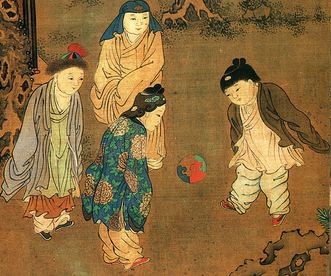China Invented Football
| Arthur Dominic Villasanta | | Jun 15, 2014 01:29 AM EDT |
Chinese playing cuju, now called football, in the 11th century.
With all due respect to the proud English, it was the Chinese that invented football.
Now I know that's blasphemy, but before you start hurling your 2014 FIFA World Cup football shoes at me, hear me out.
There is proof, yes, proof that (1) the Chinese invented the game of football, which they called "cuju," in either 2 BC or 3 BC; (2) the world's first football club was organized in China in 10 AD (3) the Chinese had their own version of the World Cup as early as 10 AD and (4) the Chinese invented the air filled football we play with today.
Like Us on Facebook
Chinese historians describe cuju as a competitive game that involves kicking a ball through an opening into a net. Cuju also didn't permit players to use their hands to control the ball. Sounds familiar?
Cuju was first mentioned in the "Zhan Guo Ce" or "Strategies of the Warring States." This famous historical work is a compilation of materials on the Warring States period put together between 476 BC to 221 BC.
Cuju was apparently intended as a sport to keep Chinese cavalrymen fit when they weren't trampling over the opposition in battle. The game was so addictive (any football fanatic today will attest to this) that cuju also became popular with the royalty and the ruling class. The Han emperor Wu Di is said to have enjoyed playing cuju.
Cuju matches played by the royalty were often held inside the imperial palace. A special type of playing field called a "ju chang" was built especially for cuju matches. The ju chang had six crescent-shaped goal posts at each end.
The rise of the Tang Dynasty (618 AD-907 AD) saw important improvements to cuju. A key change involved replacing the original feather-stuffed ball with an air-filled ball consisting of two layers.
The unwieldy goal posts were also simplified. Instead of six crescent-shaped goal posts, the new goal posts consisted of two upright posts with a net strung between them. Sounds familiar, too?
These improvements boosted the popularity of cuju during the Tang Dynasty. The empire's capital at Chang'an was said to be dotted with cuju playing fields.
Imperial soldiers and the emperor's elite guard formed cuju teams that played before the emperor and his court. Even scholars played the game. Records from that era also show the existence of all-girl cuju teams.
Cuju continued to grow during the Song Dynasty (960 AD-1279 AD). Professional cuju players became superstars, much like they are today.
Under the Song, cuju clubs were organized in large cities. Qi Yun She or Yuan She is regarded as the earliest professional cuju club.
Chinese chroniclers claim cuju spread to ancient Greece and then England. The case for cuju being the direct historical ancestor of football as we know it today is supported by the current FIFA President, Sepp Blatter.
Because of Blatter, FIFA sees cuju as the earliest form of football for which there is evidence.
Defenders of English football, on the other hand, say calling cuju the forerunner of football is speculative at best. They note that interpretations of ancient Chinese historical records about cuju are in conflict with each other.
They point out that the football of today, or the sport governed by FIFA, is based on Cambridge rules football. The origins of this type of football can be traced back to a very different ball game called "mob football" that was first played in Britain during the Middle Ages.
Tagsinvented, Football, cuju, history, FIFA World Cup Brazil
©2015 Chinatopix All rights reserved. Do not reproduce without permission
EDITOR'S PICKS
-

Did the Trump administration just announce plans for a trade war with ‘hostile’ China and Russia?
-

US Senate passes Taiwan travel bill slammed by China
-

As Yan Sihong’s family grieves, here are other Chinese students who went missing abroad. Some have never been found
-

Beijing blasts Western critics who ‘smear China’ with the term sharp power
-

China Envoy Seeks to Defuse Tensions With U.S. as a Trade War Brews
-

Singapore's Deputy PM Provides Bitcoin Vote of Confidence Amid China's Blanket Bans
-

China warns investors over risks in overseas virtual currency trading
-

Chinese government most trustworthy: survey
-

Kashima Antlers On Course For Back-To-Back Titles
MOST POPULAR
LATEST NEWS
Zhou Yongkang: China's Former Security Chief Sentenced to Life in Prison

China's former Chief of the Ministry of Public Security, Zhou Yongkang, has been given a life sentence after he was found guilty of abusing his office, bribery and deliberately ... Full Article
TRENDING STORY

China Pork Prices Expected to Stabilize As The Supplies Recover

Elephone P9000 Smartphone is now on Sale on Amazon India

There's a Big Chance Cliffhangers Won't Still Be Resolved When Grey's Anatomy Season 13 Returns

Supreme Court Ruled on Samsung vs Apple Dispute for Patent Infringement

Microsoft Surface Pro 5 Rumors and Release Date: What is the Latest?










